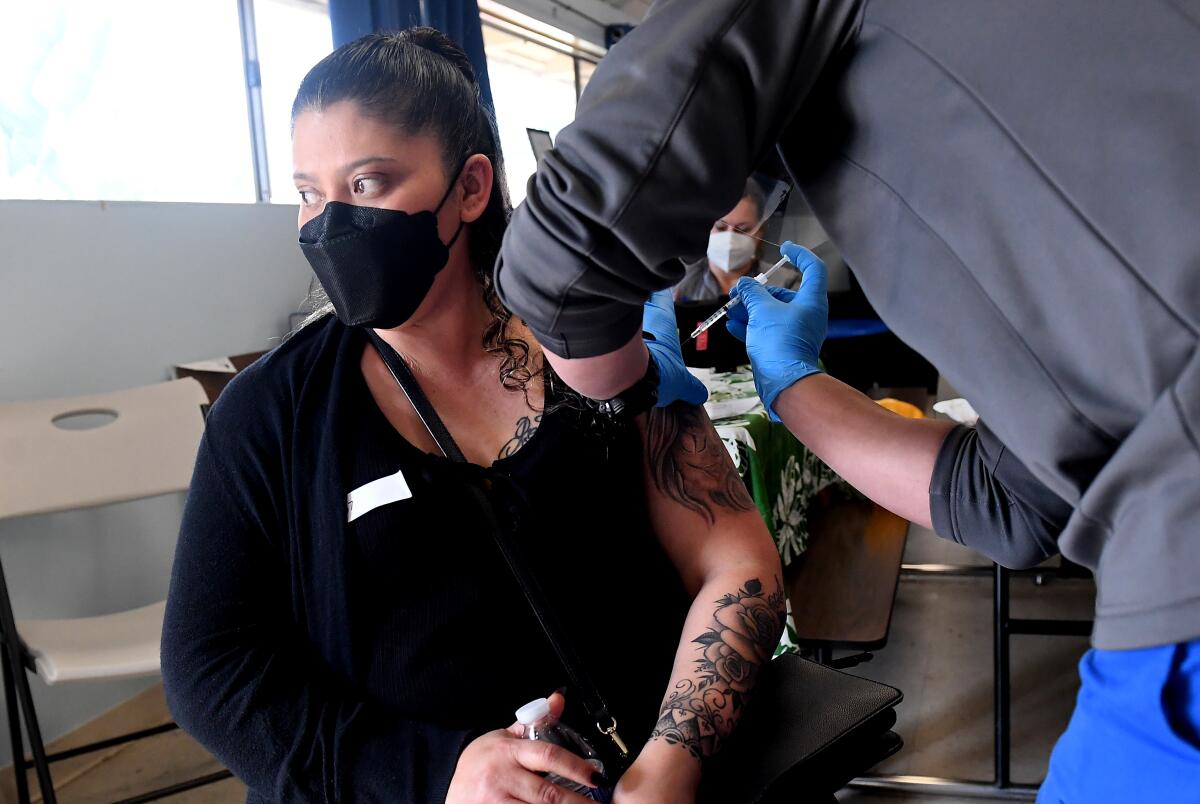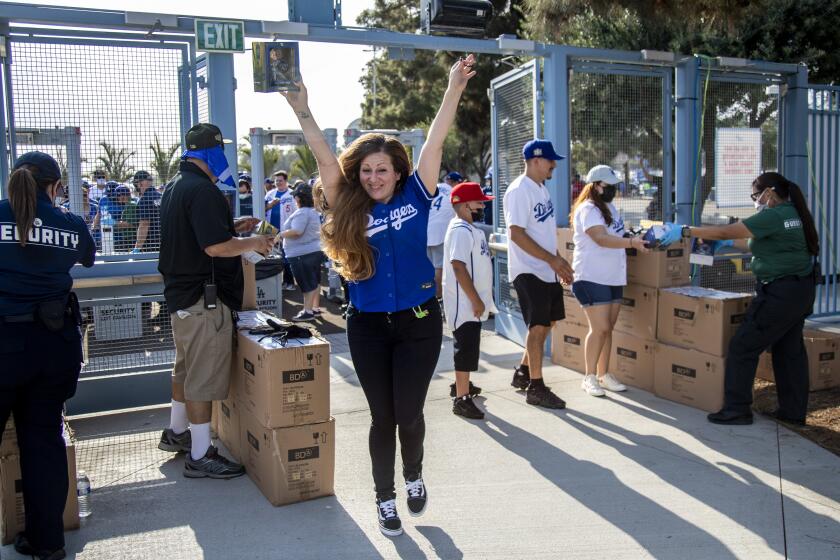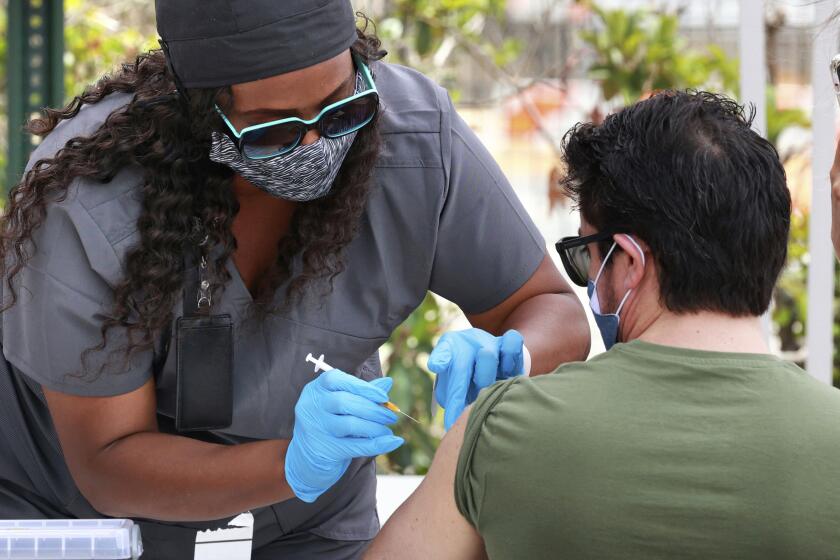Black, Latino residents see less progress in coronavirus case rates than whites in L.A. County

- Share via
In a sobering sign of the unequal health outcomes of the pandemic, coronavirus case rates are improving at a slower pace for Black and Latino residents of Los Angeles County than for white and Asian American residents.
When calculated over a two-week period, coronavirus case rates for Black residents dropped by 13% over the past month and by 22% for Latino residents, while falling by 33% for white and 45% for Asian American residents.
And while hospitalization rates have fallen by 11% over the same time period for Black residents, they dropped by 34% for Latinos and whites and 50% for Asian Americans.
“As the weeks pass, we are seeing significant decreases — which is great in our overall rates — but they also are not distributed equally among racial and ethnic groups in our county,” L.A. County Public Health Director Barbara Ferrer said.
The disparities are also reflected in vaccination rates. As of last week, 43% of Black and 52% of Latino residents of L.A. County had received at least one dose of vaccine, compared to 64% of white, 61% of Native American and 74% of Asian American residents.
“Throughout this pandemic, we have often seen two very different versions of the county: one in areas of the county with higher COVID rates, notably the Latinx and Black communities, and another where residents were able to safely and comfortably stay at home,” L.A. County Supervisor Hilda Solis said. “The Delta variant may again create a tale of two counties if residents do not get vaccinated.”
L.A. County is reporting about two COVID-19 deaths a day, while the Bay Area is reporting four.
Black residents are testing positive for the coronavirus, and being hospitalized for COVID-19, at more than twice the rate of white residents.
For the two-week period that ended June 12, for every 100,000 Black residents, 40 people were diagnosed with a coronavirus infection. But for every 100,000 Latino residents, 21 tested positive for the virus; for every 100,000 white residents, 16 tested positive; and, for every 100,000 Asian American residents, six tested positive.
Among hospitalizations, for every 100,000 Black residents, 8.1 people were in the hospital with COVID-19; for every 100,000 Latino residents, 5.3 were hospitalized; for every 100,000 white residents, 2.9 were hospitalized, and for every 100,000 Asian American residents, 1.1 were hospitalized.
Immunization rates vary widely by community: areas of the county where 75% or more of residents age 16 up are vaccinated include places like the Los Angeles neighborhoods of Brentwood, Encino, Studio City, Century City and Playa Vista, Pacific Palisades, Hancock Park, and downtown, and the cities of La Cañada Flintridge, Temple City, Sierra Madre, San Gabriel, Redondo Beach, Hermosa Beach, Santa Monica, San Marino, Cerritos, El Segundo, Monterey Park, South Pasadena, Rolling Hills Estates, Manhattan Beach, Culver City and Irwindale.
Places where 55% or fewer of residents age 16 and up have received at least one dose include Palmdale, Compton, Florence-Firestone, Willowbrook, Castaic, Lancaster, and, within Los Angeles, neighborhoods across South L.A., including Watts, as well as Tujunga and Westlake.
Ferrer said people who aren’t yet fully vaccinated should be “super, super careful,” and continue wearing masks, especially when indoors, as well as in outdoor crowded situations. Upgrading to a respirator that filters out very tiny particles, like an N95, KN95 or KF94 mask, can enhance protection for unvaccinated people.
The U.S. is reaching a pair of encouraging milestones as the COVID-19 pandemic’s grip on the nation continues to loosen.
Ferrer has estimated that getting 80% of all residents 16 and older vaccinated will enable L.A. County to reach herd immunity, also known as community immunity. That’s when enough people have immunity to the virus that it’ll protect even unvaccinated people from getting infected with the virus.
Currently, 67% of L.A. County residents in this age group are at least partially vaccinated, and 58% are fully vaccinated.
She initially expressed hope L.A. County would reach herd immunity by late July. The county’s latest projection shows it may take until the end of summer to reach that threshold.
State officials have long sounded the alarm regarding lagging vaccination rates among Latino and Black Californians — with Gov. Gavin Newsom regularly saying that equity must be the “North Star” of the state’s inoculation campaign. Statewide, 41% of Black and Latino Californians have received at least one dose of vaccine, while 56% of white, 53% of Native American and 69% of Asian/Pacific Islander residents are at least partially vaccinated.
“We have stubborn work to do to make sure that these vaccines are available in a more equitable manner to the Latino community and the African American community,” he told reporters last week at Six Flags Magic Mountain.
The state’s efforts have included designating 40% of available COVID-19 vaccine supply for communities in the lowest 25% of a socioeconomic measuring tool called the California Healthy Places index.
“The opportunities really lie in those ... communities, where there’s still a lot of questions. We still can do some work to make it more convenient to get people vaccinated, where people want to see their neighbors who did get vaccinated live to tell about it, earn the benefits from that,” state Health and Human Services Secretary Dr. Mark Ghaly said during a recent virtual interview with the Public Policy Institute of California.
Public health officials have long noted that poverty and other deep-rooted inequities ultimately left some Californians at far greater risk of COVID-19 exposure than others. “We saw in the realest, hardest ways if you could afford to stay home, order food, have things sort of done for you ... that you were generally going to be safe,” Ghaly said. “But if you didn’t have that option, because your livelihood didn’t allow it, you know you were vulnerable in a way.”
More to Read
Sign up for Essential California
The most important California stories and recommendations in your inbox every morning.
You may occasionally receive promotional content from the Los Angeles Times.















